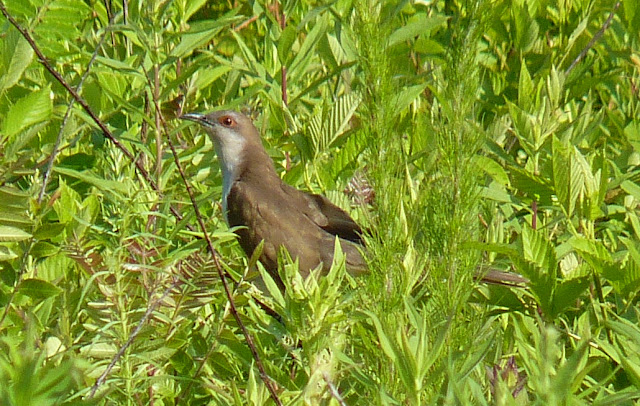2012 was another great year of birds for me.
I saw 390 species of which 59 were lifers. These numbers are down a bit from
last year (405 species with 92 lifers), but that's a function of no travel to foreign continents and diminishing returns on local opportunities for life birds. And I did significantly better in state, with 301 NC birds this past year compared 283 species in 2011.
On an even more local level, I was finally able to catch Robert Meehan at the top spot for Durham County. I'm sure we'll pass the lead back and forth as we each fill "holes" in our respective lists over the coming year.
My main opportunity for exotic birds this year was a trip to the island of Hispaniola where
I birded both Haiti and
the Dominican Republic. Haiti is an especially under-birded country; the 47 species I spotted there in a few days was enough to make me the second-most prolific ebirder for the country in 2012.
Like the last two years, I'll celebrate its completion with a narcissistic look back at my 10 awesomest/best/favorite "self-found" birds of the year. And again, it will be a challenge to see which of my loyal readers has seen the most. Post your total in the comments below! Win a prize!
The list...
#10: Least Bittern
This is not an especially rare bird (though it did not make the list of 340 species that Jeff Lemons saw in NC in 2012), but I had wanted to see a Least Bittern for awhile and I managed to cross paths with them on three occasions in 2012.
The first was at Brickhouse Road in Durham where one responded to tape. This was bittersweet, though...it was great to find this bird in my home county, but I had to place it on my "heard-only" provisional list...
 |
| Least Bittern, Viera Wetland, FL |
Of course this felt a bit like cheating and I still hadn't seen one in North Carolina...
 |
| Least Bittern, Lake Mattamuskeet, NC |
#9: Long-tailed Jaeger
Now this is a bird I probably would not have even been able to identify (or at least without careful study of photos after-the-fact) if Brian Patteson hadn't called it for the boat. But it was a special sighting for me because it was the best bird we found on
my first ever pelagic trip as a spotter.
 |
| Long-tailed Jaeger (immature), pelagic off Cape Hatteras, NC |
It also closed out the jaegers for me. Now if I can just find a South Polar Skua, then I'll have all the Stercorarius that occur in NC.
#8: Ash-throated Flycatcher
 |
| Ash-throated Flycatcher, Washington County, NC |
This is the only bird on the list that wasn't a lifer for me, but it's probably the best bird I found without any help from Brian Patteson or John Fussell this year (and possibly my best ever for NC).
Also I got pretty good digiscoped photos of it.
 |
| Ash-throated Flycatcher |
#7: Little Gull
I spotted one of these migrating north in a flock of Bonaparte's Gulls a couple days before my 27th birthday. Not a bad present from the birding gods!
 |
| Little Gull with Bonaparte's Gulls, Emerald Isle, NC |
I was doing some experimenting with digiscoping at the time and managed this shot that captures the dark underwing. Yeah it looks terrible, but I was happy to get any sort of record given the circumstances (distant bird over choppy ocean moving fast).
Little Gulls are pretty rare. I guess I should mention that.
#6: Hispaniolan Crossbill
This species is listed as endangered by the IUCN and is odd in that the rest of the members of the Loxia genus, to which it belongs, are found primarily at high latitudes. These birds managed to persist in the mountains on the Island of Hispaniola and are found nowhere else in the world.
 |
| Hispaiolan Crossbill, Dominican Republic |
It's a species that can be easily missed, but I was lucky to find flocks in high elevation pine forests in both
Haiti and
the Dominican Republic.
#5: Black-billed Cuckoo
 |
| Black-billed Cuckoo, Croatan National Forest, Craven County, NC |
The bane of many an American birder, the Black-billed Cuckoo, is an enigmatic bird with breeding habits and behavior that are poorly understood. I met John Fussell out in the Croatan National Forest in July where he had recently heard Black-billed Cuckoos singing. There
we found an adult feeding a fledging; the first record of breeding Black-billed Cuckoos in the NC Coastal Plain in more than 100 years.
#4: Bay-breasted Cuckoo (Cua)
#3: Golden Eagle
 |
| Golden Eagle, Gull Rock Game Land, Hyde County, NC |
One of the better birds I've ever "self-found" and a nice addition to
the 2012 Mattamuskeet Christmas Bird Count. This one was bullying on a Bald Eagle over a flooded field in Gull Rock Game Lands. Golden Eagle had been on my target list for a couple years now.
#2: Black Rail
One of the most impossible-to-see of all North American birds flushed from my feet in the marsh at Gull Rock Game Land. I think this was the first ever Black Rail found on
the Mattamuskeet Christmas Bird Count. And it was another species I've been hoping to cross paths with for quite awhile.
#1: Black-browed Albatross
 |
| Black-browed Albatross, pelagic off Cape Hatteras, NC |
**************
How many of these 10 have you seen? How many did you see in the past year? Let me know in the comments!
Free Brown Boobies T-shirt goes to the winner!


















